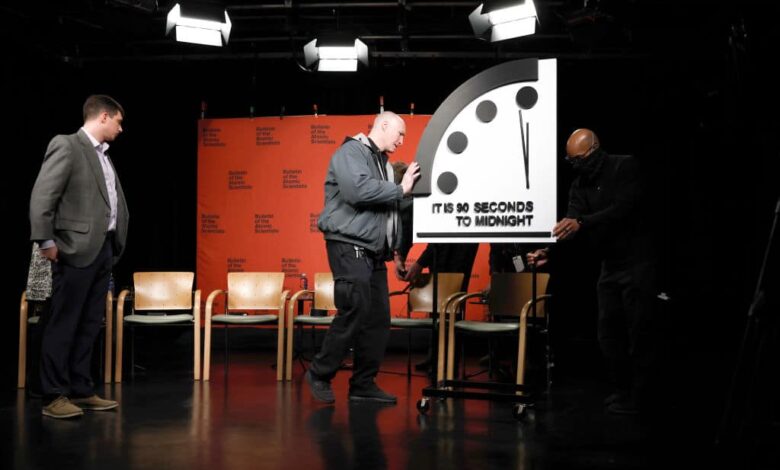2023 DOOMSDAY CLOCK

The hands of the Doomsday Clock, used by top scientists to assess how close humanity is to self-annihilation, moved forwards to 90 seconds to midnight on Tuesday, the highest threat level in the project’s history here are the highest threat levels previously reached.
The Doomsday Clock is a symbol of how close humanity is to self-annihilation. It was created in 1947 in the wake of the world’s first nuclear detonations by the Bulletin of the Atomic Scientists, a group of scientists who had worked on the Manhattan Project, the U.S. endeavor responsible for developing the world’s first nuclear weapon.
Experts say it is best to use the timings as a way of stimulating discussion, highlighting risks and as a wake-up call rather than a strict risk assessment or indication of time humanity has left. The clock was originally set at seven minutes from midnight in 1947 and the furthest from midnight it has ever been set was 17 minutes in 1991 following the fall of the Soviet Union and signing of the Strategic Arms Reduction Treaty.
TIMELINE
2 minutes to midnight. 1953.The Bulletin moved the clock the closest to midnight it had ever been—and the closest it would ever be in the 20th Century—after the U.S. and the Soviet Union detonated their first thermonuclear weapons.
2.5 minutes to midnight. 2017.The Bulletin said the “words of a single person,” Donald Trump, had motivated the decision to move the clock 30 seconds, having “made a bad international security situation worse” despite only having been president for a matter of days at the time of the announcement.
2 minutes to midnight. 2018.Nuclear concerns were once again center stage when the Bulletin returned the clock to two minutes to midnight in 2018, when the group said major nuclear powers were on the “cusp of a new arms race.”
2 minutes to midnight. 2019. The Bulletin listed the U.S.’ departure as a global nuclear leader, particularly its abandonment of the Iran nuclear deal and withdrawal from the Intermediate-range Nuclear Forces Treaty, as ”grave steps towards a complete dismantlement of the global arms control process” and a key reason for keeping the clock at 2 minutes to midnight.
100 seconds to midnight. 2020.The Bulletin of Atomic Scientists, which oversees the clock, said the twin risks of nuclear war and climate change, compounded by the spread of misinformation and behavior of world leaders, justified moving the clock forwards to 100 seconds to midnight, the closest to midnight it had been before Tuesday’s update.
100 seconds to midnight. 2021.The Bulletin cited “accelerating nuclear programs in multiple countries,” the Covid-19 pandemic and the continued failure of governments to tackle climate change as reasons to keep the clock at 100 seconds to midnight, illustrating that “we are stuck in a perilousmoment.”
“Russia’s invasion of Ukraine has increased the risk of nuclear weapons use, raised the specter of biological and chemical weapons use, hamstrung the world’s response to climate change, and hampered international efforts to deal with other global concerns,” the Bulletin of Atomic Scientists said in its 2023 statement. Moscow’s violation of longstanding international norms could also “embolden” other nations to do the same, the statement said.




